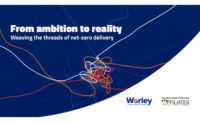AECOM has further refined its corporate-wide environmental, social and governance (ESG) goals, highlighting its intent to “embed” sustainability and resilience across the company’s work, improve “social outcomes” for communities, strengthen climate change mitigation and set new staff diversity goals, the firm said April 26.
The design giant said the ESG strategy includes its goal to be operationally carbon net zero by year-end, take further steps to meet Paris Accord targets by 2030 that include decarbonized fleet vehicles and carbon measures in procurement, and engage in a new effort called Scope-X to cut carbon emissions through design across the entire project life cycle.
AECOM also set targets for women to make up at least 20% of its senior leadership and at least 35% of its workforce in the "near term."
“We have a responsibility to embed ESG principles into everything we do to ... advance complex, multi-decade sustainability initiatives,” said Troy Rudd, CEO of AECOM and former COO of its Americas design and consulting services business.
Firm President Lara Poloni noted clients’ “evolving priorities focused on sustainability and delivering social impact through their projects and services,” with AECOM in a position to “advise and execute.”
Rudd was elevated to CEO last July in a then-controversial selection not universally supported by its board directors to succeed the retiring Michael Burke. Despite pandemic impacts, the executive, also a former AECOM CFO, led the firm to post 2020 financial results welcomed by investors and analysts.
Accelerated ESG
Not unlike other companies boosting ESG strategies, the firm last year accelerated its corporate focus with the launch of its Thrive with AECOM initiative that commits to diversity, equity and inclusion efforts and science-based carbon emissions cut targets.
"A year ago, we decided to make it part of everything we do. This is what our clients and people were telling us,” Rudd told ENR. “We’re doing things everyone is focused on. We’re looking at our carbon footprint. We need to make it a big production. It’s what employees want too.”
Rudd said the Scope-X effort is a first for the company and aims to reduce carbon on major projects by at least 50% through design that considers embodied and operational carbon.
“We wanted to define it so people are thinking about it,” Rudd said. “We named it so our people are talking to clients about it.” He adds the firm has 1,500 private sector clients and 800 in government that “have their own targets and have approached us” for assistance in developing ESG goals and how to reach their targets. “This is part of every project we’re working on.”
AECOM has been working with Los Angeles officials for a year to help design a way to meet Mayor Eric Garcetti's goals to move its bus fleet off fossil fuels through energy infrastructure design, distributed energy resource integration and alternative delivery strategy analysis.
“How do you create the infrastructure to support this effort and how do you get the power to charge bus batteries overnight?” Rudd said, also noting the need for funding approaches with the broad public sector's “pandemic deficit.” He said AECOM has been exploring private funding sources.
In another example of ESG work, AECOM announced last month the first large-scale field demonstration project in Melbourne, Australia, using mobile pilot plants to destroy PFAS chemicals without generating hazardous waste. The company uses its patented and proprietary DEFLUORO technology that breaks down PFAS molecules. The process also is being tested in the U.S.
According to Rudd, the company anticipates the technology will be "commercial” by the end of summer. “This is us making the investment in technology driven by the environmental agenda,” he said.
Design Matters
The diversity goals for women include new efforts to develop project teams that reflect clients and communities served, said Rudd, with other efforts to partner with small and medium entities and deliver projects that “proactively improve social value outcomes.”
Rudd noted efforts also are underway related to minority recruitment and promotion, although the effort is not spelled out in an ESG goal. “We’re a global company, and equity looks different around the world,” he said, noting some countries prohibit race and ethnicity profiling of employees.
“We have a commitment to improve DEI but it’s different globally,” said Rudd, noting corporate-wide unconscious bias training for employees, and training and development efforts in minority communities. “The most important impact is to change someone’s life for a generation,” Rudd said, noting AECOM efforts to encourage STEM as a career choice and its outreach to minority-owned businesses on projects.
The program also ties leadership ESG accountability on projects through annual audits of specific performance targets “in line with leading industry benchmarks.” Says Rudd: “It’s important and starts at the top.”
Related to recent U.S. Securities and Exchange Commission statements to insure ESG accuracy and transparency, Rudd noted that AECOM in Februaryt completed an ESG-linked financing, in which borrowing costs are tied to achieving its goals for emissions cuts and diversity. “If we don’t, the cost of financing goes up,” says Rudd. It is the second major professional services firm in North America to do so, following Canada-based WSP Global last year.
AECOM in February ranked first on Fortune magazine’s list of leading global companies in professional services, based on a survey of industry executives, directors and analysts assessing nine criteria—from investment value and quality of management and products to social responsibility and ability to attract talent.
Executive Pay Links
According to S&P Global, nearly half of the U.K.'s 100 largest companies now use an ESG measure when setting targets for executive pay, indicating more corporate acceptance of the metric, based on research last month by London Business School and PricewaterhouseCoopers.
Another study said while 11% of Europe's top 350 companies have CO2 emissions cuts linked to executive incentive plans, only 2% of U.S. S&P 500 companies have them.
One executive compensation and corporate governance consultant told Pensions and Investments, an on line financial publication, that "investors are really pressuring" corporations to focus on ESG, particularly as COVID-19 highlights its competitive importance for growth and talent recruitment.
With AECOM’s shedding of high-risk construction units virtually complete, the firm has “no plans for large M&A of any kind," said Rudd. "We have size and scale and can do it organically.”
The CEO noted, however, there “may be exceptions” related to technology purchases. The firm will be “more explicit about how we commercialize ... awesome innovations.” Rudd said. “How we deliver work is an important part of our strategy.”
AECOM ranks second on ENR's just issued Top 500 Design Firms ranking, reporting $7.8 billion in 2020 design revenue. It leads the top 10 firms in transportation, buildings and global design sectors, and is second in water and hazardous waste engineering.
Related to the future of AEC work environments post-pandemic, Rudd said that “we don’t need to be in an office to successfully work together. Clients are happy with how we’re working, maybe more understanding.”
Despite a 30% real estate cut that AECOM anticipates, with smaller, more dispersed offices, “we still have room to grow,” he pointed out.
Rudd declined to speculate on AECOM's second-quarter revenue, earings an backlog results, set to be aired on May 11, but noted “opportunities in front of us that are better and better,” and said he is “comfortable” the firm can double earnings in the next three years. “My job is to make sure we’re prepared for all outcomes—if there is a [U.S.] infrastructure bill or not,” he said.
According to Rudd: "This year, we’re grinding through with COVID impacting still. Trends are leading to 2022 as the beginning of the infrastructure investment cycle and long-term investment.”






Post a comment to this article
Report Abusive Comment